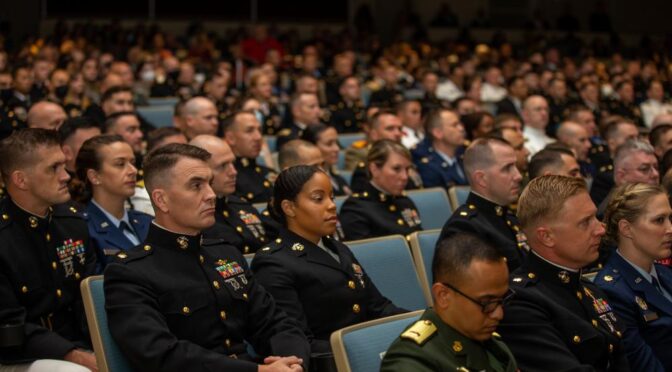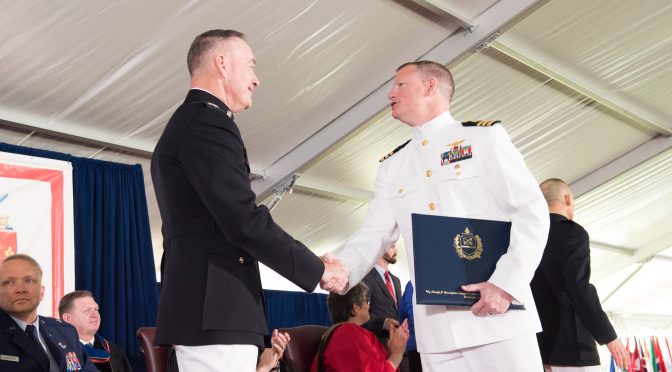By Bobby Holmes
If the sea services and the defense community are to improve and sustain human capital to accomplish the missions of the future, they must create a more educated workforce by incentivizing nontraditional and self-study Professional Military Education opportunities. War is a human endeavor. This fact applies universally to all conflicts, regardless of when they are fought, where there are fought, or what weapons are used to fight them. The human factors of war dominated Napoleonic Europe and the trenches of World War I, just as they did in Al Anbar for the last two decades and in Kharkiv today. Any future conflict, particularly between great powers with technologically exquisite platforms, will be built on a human foundation. The United States Department of Defense and the sea services must invest in their people as much or more than they invest in their things.
Professional Military Education (PME) is a key vessel for this human investment, but the sea services are not doing enough to compel their top performers to seek out valuable PME as a career enhancing opportunity. Put more emphatically, there is not enough incentive for Sailors, Marines, and Coast Guardsmen to pursue self-study education programs, either concurrently to their primary MOS duties or as part of a dedicated PME tour. This lack of incentive is best reflected in the risk one assumes to their chances of O-5 promotion and command tours should they embark on a nontraditional PME program. This causes an exodus of the sea services’ top performers before their talents can be fully utilized. Adding additional PME opportunities reserved for top performers and decoupling nonstandard PME and decreased promotion and command opportunity will go far in developing a more intelligent naval workforce that is well prepared for the future’s challenges.
The Problem
The personnel evaluation systems of the sea services do not create incentives for well-meaning servicemembers to pursue nontraditional or self-study PME. In any fleet unit, the axiom that “learning is good, but doing is better” reigns supreme.1 The command climates throughout the naval workforce implicitly communicate this through evaluation methods that are abstractly comparative and do not adequately reflect the gains to be had from a more educated and intelligent workforce. The metrics used to compare servicemembers against each other are largely the same across each service’s force and do not appropriately weight self-study PME against basic MOS proficiency. Any time spent studying and learning beyond typical MOS training and standard “roadmap” PME courses is viewed as time that could be better spent in the office or in the field. While this article does not argue in the least against putting the time in when it is needed, the most driven servicemembers should have more and better opportunities to self-educate.
Moreover, it is nearly impossible to communicate to one’s chain of command when gains in technical competence or tactical proficiency are earned through individual PME. While these gains may be lauded for what they are, the return on investment for the individual servicemember does not hold. This feedback loop then creates a self-fulfilling prophecy at the institutional level: the sea services’ top performers writ large do not pursue self-study PME because this is time they must spend outperforming their peers in basic tasks and duties, and connecting this outperformance to additional PME is not feasible in most command climates. Note that this argument does not mean that a poorly performing Marine should be able to just read a book to compensate for their shortcoming; it means that an imminently qualified Marine should not be penalized for pursuing a nontraditional education program that is concurrent to their professional duties, assuming their performance is already above reproach. If the sea services can modify their evaluation practices, the best members will take advantage of it, and the services will collectively benefit from a more educated force.
The final deterrent to many servicemembers’ aspirations towards PME and career progression comes in the form of increased risk to O-5 promotion and command opportunities. Simply put, the sea services do not value increased education as much as they do increased experience. Promotion boards expect to see a standard conveyor belt of “key billets” that culminates in a selection to O-5 command. While certain levels of experience are necessary to ensure successful and effective command, this model creates institutional groupthink amongst its leaders and stifles the creativity of its most imaginative service members.
Promotion boards reinforce this trend through the people and career paths they prioritize for promotion and command. This reinforcement then trickles down and compels resultant career decisions amongst the company grade officers and junior staff noncommissioned officers throughout the individual services. Even those who would prefer a nontraditional PME approach do not seek it out simply because they cannot assume the risk to their career. This hesitancy is amplified by the services’ manpower management practices, which are designed to check requisite career progression boxes that collectively make members competitive for O-5 command.
This requirement to maintain competitiveness for O-5 command is present whether a particular servicemember wants the opportunity or not. The sea services are missing a valuable opportunity and bypassing a valuable talent pool strictly through the use of a short sighted and outdated promotion model. Everyone is treated like they are a future ship’s captain or infantry battalion commander – regardless of personal aspirations – and this is a mistake.
A Proposed Solution
This article now proposes two potential answers to the aforementioned problem. Both are designed to increase the incentive for servicemembers to pursue self-study PME, with one approach creating the opportunity to do so and the other removing any potential negative side-effects to one’s career progression.
1) Choose Your Own (PME) Adventure: If the sea services want to truly revamp and weaponize their approach to PME, this is one of the most nontraditional opportunities to do so. PME selection boards – be they for company grade, field grade, or top level school allocations – can set aside a small portion of their allocations for only the highest performing servicemembers on the board and allow them the chance to design their own PME program. Prospective students would get to pick the school (a traditional university, PME institution, trade school, or other options), the field of study, and the recommended utilization tour upon completion of the program.
There are two methods to solicit these programs. The first is to field said programs from individuals seeking to embark on them before a given PME selection board convenes. Boards will then convene and determine, much like they do for every PME program, if the requested program fits the needs of the service and the servicemember is of sufficient quality and talent to warrant approval to the program. The second method is to select those servicemembers for this self-designed PME option, then instruct them to build and submit their program for approval. Either approach is feasible, however the first approach of solicitation then allocation most likely nests better within the current timelines of PME selection and rotation dates.
Note that this option is in no way a “free ride” or “vacation” for the servicemember. Potential self-designed programs should nest within a member’s professional duties and fit the general needs the member fulfills for the service. The servicemember, who will most likely spend a considerable amount of time away from traditional military installations and communities, should also uphold basic tenets of military life (physical fitness, military appearance, off duty conduct, etc.) throughout the program. Moreover, these programs would also warrant substantial utilization tours and service obligations once completed, so the services will benefit from continued retention of their best performers in fields these members actually want to be in. The author is not naïve to personnel requirements of the sea services and this option is not meant erode the potential pool of ships’ captains, department heads, or battalion commanders. It is merely an entrepreneurial recommendation for the services to better utilize their top performers, with effects that will ripple down throughout the entire force.
2) “Learn More and Do Better”: The sea services must eschew the notion that “learning is good but doing is better.” This is a false dichotomy that assumes a zero sum game between personal development and professional competence, where one comes at the expense of the other. This is ridiculous, yet promotion boards implicitly communicate this at every convening. Myopic rules about what constitutes a “key billet in grade” should be discarded in favor of a more wholistic look at the entire person up for promotion or command. Is the Marine Corps really assuming increased risk by promoting an already high performing and self-educated Major to Lieutenant Colonel without a traditional Executive Officer or Operations Officer tour? This article submits that there is minimal risk in this decision. Is there a proper combination of education and experience that can allow a potential ship’s captain to bypass a department head tour in favor of a nontraditional education program? This article again posits that there is indeed a combination of learning and doing that can compensate for the standard cookie cutter approach of career progression.
What this requires is a massive shift in the mindset of the services and their leaders. Once promotions and command allocations better account for self-driven PME, trust will rise amongst the naval workforce to pursue individual improvement opportunities. The relationship between personal development and professional competence is not zero sum but complimentary. By learning more, servicemembers will do better.
Conclusion
The sea services will need people – not equipment – to do the hard things that are sure to come in the next conflict. The wars of the future will transcend current known quantities such as weaponeering and single domain warfare. This future war will be cognitively rigorous, and the leaders who can think effectively first will be the ones who attack effectively first. An educated and intelligent naval workforce is a requirement if the sea services are to succeed in these future wars. Professional Military Education, long an area of investment in our human capital, needs to be revamped and better weaponized to attract and retain the brightest minds in the naval force. Leaders at all levels must provide incentives for self-study PME, not judging it against time spent in the office but more so as a compliment to this time. Leaders must also realize when individual increases in proficiency arise from entrepreneurial PME initiatives and laud them.
Institutionally, the sea services should allow for the best and brightest servicemembers to design their own PME program, provided that it nests within their professional duties and the needs of the service. The services’ highest leaders must champion the notion that education does not equal a degradation of experience but more so an increase in potential performance. Promotions should reflect this shift in mindset, effectively communicating to the workforce that there is minimal risk to one’s career if they seek out education. Combining these grassroots and institutional-level efforts will increase the intelligence and commensurate performance of the naval workforce, provide apparent levels of career satisfaction for all involved, and allow the sea services to better fight and win the next war.
Captain Robert Holmes, USMC, is a graduate student of Eurasian regional security studies and a Eurasian Foreign Area Officer at the Naval Postgraduate School.
Endnotes
1. James Wirtz, “The Reluctant Theorist: Colin Gray and the Theory of Strategy,” Infinity Journal (March, 2014): 14.
Featured Image: Students with the Marine Corps University (MCU) participate in the MCU Commencement ceremony at Little Hall, Marine Corps Base Quantico, Virginia, June 8, 2022. (U.S. Marine Corps photo by Cpl. Eric Huynh)



